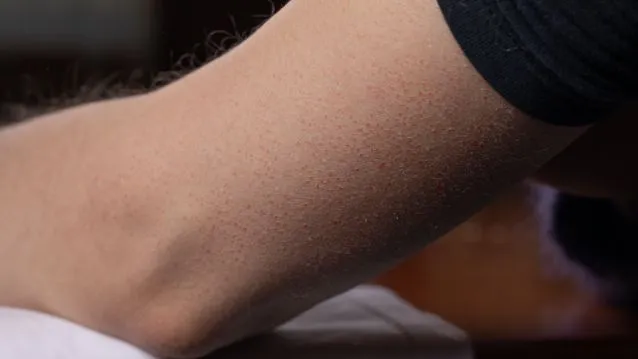Do you have “goosebumps” even when you’re not cold? Does your skin show tiny red spots that never go away? You may have keratosis pilaris.
Keratosis pilaris affects nearly 50 to 80 percent of all adolescents and approximately 40 percent of adults. The areas that most commonly show symptoms include the upper arms (92 percent of cases), thighs (59 percent of cases), and buttocks (30 percent of cases). Some people also get bumps on the face, which can be particularly bothersome. Luckily, this skin condition is very common and completely harmless. Understandably though, you may feel a little less confident sporting those summer tank tops, bathing suits, and sundresses when you have rough or spotty skin.
This common condition is caused by a simple build-up of a protein called keratin. The resulting clogged pores can cause inflammation or redness in the area, and they make the skin look and feel rough. Dry skin, cold weather, pregnancy, high levels of estrogen, shaving, or waxing can all worsen the symptoms. Some people may mistake their keratosis bumps as acne and pick at them, leaving sores and scars, which only make the condition of the skin worse.
While you may have been told that these unsightly bumps are a permanent condition, luckily, there are a few simple and natural treatments that may help improve the look and texture of your skin.
How to get smooth, silky bump-free arms
If you follow the conventional route, you can easily spend tens or hundreds of dollars on scrubs, peels, creams, and serums that will only reduce keratosis pilaris symptoms without fixing the root cause. We’ve looked into a more holistic approach that can help your skin heal from the inside out.
The first item on your keratosis pilaris to-do list is actually a “not to-do”: do not exfoliate! It’s completely understandable if your first impulse every time you feel those bumps is to seize the loofah and go to town on that rough skin – but this can serve to further irritate those clogged hair follicles. Also, avoid hot showers and baths, as they dry out the skin, causing further irritation. Stick with cooler showers and leave your skin alone for the time being until you’ve completed the next critical step.
What to eat for healthy skin
Conventional practitioners are quick to call keratosis pilaris “uncurable” because studies have shown it has a genetic component, meaning that a person is more likely to have it if a family member has it (and is therefore stuck with it for life). However, while a person may be genetically predisposed to having this skin condition, they can prevent the symptoms from manifesting by managing factors that trigger them.
Importantly, keratosis pilaris has been observed in people with diets low in certain nutrients, such as vitamin A and vitamin C. Vitamin A assists in promoting and maintaining health in the top two layers of the skin – the dermis, and epidermis. It helps to support the skin’s immune system, promotes natural moisturizing, and speeds skin healing. All of these effects serve to hydrate the skin effectively, giving it a radiant glow. Other nutrients such as vitamin C and vitamin D are also critical for the skin. A 2012 study highlighted how these vitamins, along with omega-3 fatty acids, promote skin health and beauty.
A deficiency of these nutrients may contribute to low-grade inflammation in the body that shows up in the hair follicle. Thus, keratosis pilaris sufferers may consider adding foods rich in vitamins A, C, and D to their diet. These include organ meats, dairy, eggs, fatty fish, mushrooms, dark leafy greens, yellow-orange colored vegetables, and fruit. A good old-fashioned cod liver oil supplement can go a long way, as it is rich in vitamins A and D, which are important for healthy skin.
Saying goodbye to those little red bumps for good
After loading up on skin-supporting, inflammation-fighting foods, try taking care of your gut health. A damaged or leaky gut can contribute to chronic inflammation, so gut issues can often manifest as skin symptoms. Cultivate a healthy microbiome and improve digestion with probiotics, cultured and fermented foods, and digestive enzymes. And, of course, if you think you may be sensitive to certain inflammatory foods like dairy or gluten, you’ll want to stop eating them too.
After you have addressed the “internal” causes of keratosis pilaris, brought your nutrient levels into balance, and reduced inflammation in the skin, you can then begin addressing the surface symptoms of the condition. This includes gentle exfoliation and consistent use of a nourishing, naturally-based moisturizer. Start from the inside out, and before you know it, you’ll be able to enjoy smooth, spot-free skin.
-Liivi Hess

